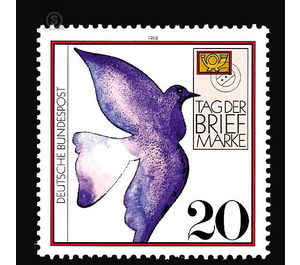day of the stamp - Germany / Federal Republic of Germany 1988 - 20 Pfennig
Theme: Post & Philately
| Country | Germany / Federal Republic of Germany |
| Issue Date | 1988 |
| Face Value | 20.00 |
| Color | white violet |
| Perforation | K 13 3/4 |
| Printing Type | Seven-color offset printing |
| Stamp Type | Postage stamp |
| Item Type | Stamp |
| Chronological Issue Number | 1261 |
| Chronological Chapter | GER-BRD |
| SID | 531747 |
| In 69 Wishlists | |
The "Stamp Day" falls on October 30, 1988. For over 50 years he is celebrated in Germany. The German Federal Post Office honors this "feast day of all philatelists" since 1975 in uninterrupted annual succession by issuing a special stamp. The Bund Deutscher Philatelisten eV, the umbrella organization for organized philately, will be promoting the appeal and beauty of collecting stamps and postal history documents on the »Stamp Day« together with the Deutsche Philatelisten-Jugend at a variety of events, exhibitions, advertising shows and exchange days In this way, try to make friends with this popular and fascinating hobby. For collectors, stamps are much more than just postage stamps or fee receipts. They are living documents of human labor and human spirit. Stamps tell of countries and their inhabitants, of history, culture, politics, technical progress, art, religion and much more. Thus, the grip on a stamp album - and will remain so in spite of all technical achievements in the future - always the shortest route to the cultural and contemporary history of a country. The motif of the special stamp for "Stamp Day 1988" is a carrier pigeon. Carrier pigeons have always been among the popular brand motifs, certainly because for centuries the dove is a symbol of communication. The well-known stamp with this motif is the "Baseler Täubchen" of the Kantonalpost Basel from the year 1845, at the same time the first multi-colored stamp in the world! As far as historians were able to explore, the first king of Egypt to use pigeons to transmit messages was around 2600 BC. The first state-organized courier post with pigeons is attributed to the Han dynasty of China in the 3rd century AD. In the Middle Ages, the Turks used in the Crusades pigeons as Depeschenträger. In the middle of the twelfth century, the Egyptian-Syrian sultans created a planned carrier pigeon post for state purposes with a network of flights from Cairo and Damascus to the most important cities in the empire. In Europe, at the earliest in the 16th century, pigeons were used to transmit messages. In the mid-19th century pigeon posts existed between Brussels, Antwerp and Paris. Stock market news and newspaper reports were delivered between Brussels and Aachen, where the Reuter office operated a pigeon post. The siege of Paris in 1870-71 brought a regular use of racing pigeons with a not insignificant success: they used balloons to fly the pigeons to the province, from where they brought messages back to the city. With the rapid development of telegraphy, the carrier pigeon post in the civilian area lost its importance. Today, the symbol of the dove is also a sign of peace and international understanding. (Text: BUND DEUTSCHER PHILATELISTEN e.V. - Federal Office for Public Relations, Frankfurt am Main)


